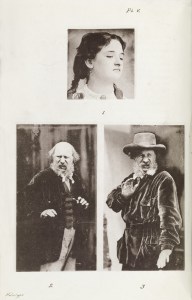By Tara MacDonald Sympathy is perhaps the most frequently discussed emotion among scholars working in Victorian literature and culture. Many have argued how important notions of sympathy and later empathy were to the development of nineteenth-century subjects and the novel as a genre. Most of these critics understand sympathy as cognitive, or as a kind of mental feeling. In Scenes of Sympathy, for instance, Audrey Jaffe draws from Adam Smith’s 1759 Theory of Moral Sentiments when she explains that “sympathy ‘does away’ with bodies in order to produce representations, replacing persons with mental pictures, generalized images of ease and of suffering” (11). Yet for many Victorian thinkers, sympathy did not ‘do away’ with the body. In fact, in Victorian scientific and philosophical writing, as well as in much literature of the period, sympathy was often understood as an affective response that was deeply physiological and embodied. Henry George Atkinson, writing to Harriet Martineau in their collaborative text Letters on the Laws of Man’s Nature and Development in 1851 called sympathies between individuals, “the influences of one organized body upon another” (117-18). If scholars working on nineteenth-century literature have been so invested in notions of sympathy as a cognitive and ultimately ethical response to reading, how might we read literary texts alongside a more embodied and potentially more ambiguous understanding of sympathy? In Darwin’s The Expression of the Emotions in Man and Animals (1872), he, like Scottish philosopher Alexander Bain earlier in the period, equates bodily sympathy to simple imitation. He gives examples of sympathy within one body: someone cutting with a pair of scissors who seems to move her jaws with the blades of the scissors or children learning to write who twist their tongues as their fingers move. He also provides examples of sympathy between bodies: when a singer becomes hoarse, audience members might sympathetically clear their own throats, for instance. In another example, he notes, “I have also been told that at leaping matches, as the performer makes his spring, many of the spectators, generally men and boys, move their feet” (109). And in my favourite example, he explains, “So strong, also, is the power of sympathy that a sensitive person, as a lady has assured me, will sometimes blush at a flagrant breach of etiquette by a perfect stranger, though the act may in no way concern her” (215). If sympathy was understood as feeling for someone or feeling with someone (even if ‘feeling with’ is now linked to empathy), this seems to me to be an example of feeling in the place of someone else! Sympathy in these examples seems to imply a kind of drifting of affect, a largely involuntary movement of sensory impressions from one part of the body to another, from one body to another, or between various bodies. How are such notions of bodily sympathy played out in Victorian fiction, I’m now wondering? I’d love to hear examples in the comments if you have some ideas. One example that comes to mind is a moment in Dickens’s David Copperfield when David responds to the older boy Steerforth. David can tell that his classmate is manipulating him, but he also is enjoying the attention he’s receiving. He recalls, “I smiled because he smiled, but I was a little troubled in my mind, too.” It’s perhaps surprising that Dickens (whom many would consider to be the primary manipulator of Victorian readers’ emotional sympathies) would be so attentive to the potential dangers of bodily sympathy. Soon after this moment, David narrates an episode in which his classmates all gang up on their teacher, Mr. Mell; when they cheer at the teacher’s (unfair) dismissal, David notes “we gave three cheers—I did not quite know what for … [I] joined in them ardently, though I felt miserable.” These are striking moments of affective dissonance as they record David’s contrasting responses. Dickens here is attentive to the (dangerously) sympathetic effects of crowds and to the way in which we can respond differently to an event affectively (meaning physiologically) and ideologically. Like Darwin, Alexander Bain, in The Emotions and the Will (1859) links bodily sympathy and imitation. Bain emphasizes that sympathy begins as an involuntary physiological reaction and that human beings have “a tendency to put on the very expression that we witness, and, in so doing, to assume the mental condition itself” (174). Bain is wonderfully utopian about such human tendencies, arguing that the “disposition to take on the states of others, irrespective of the warm attachments and likings of our nature is … the real source of our vicarious impulses, and of our generous, humane, and social sentiments; it is the disinterested element of the moral sense” (179). And this disinterested element simply lies within our perceiving bodies. While I am perhaps less optimistic than Bain, his link between bodily sympathy and morality or generosity is striking. We are far more accustomed, I think, to hearing about the ways in which involuntary or seemingly mechanistic movements could create uncanny feelings for Victorians. And his comments attest to the ways in which bodily affects could be regarded more hopefully. Are most authors of the period attentive to the dual possibilities of bodily affects? Or are acts of imitation typically regarded as frightening in mid-Victorian fiction, as they clearly are for David? Works Cited Jaffe, Audrey. Scenes of Sympathy: Identity and Representation in Victorian Fiction. Ithaca: Cornell UP, 2000. Atkinson, Henry George and Harriet Martineau, Letters on the Laws of Man’s Nature and Development. 1851. Forgotten Books, 2012. Darwin, Charles. The Expression of the Emotions in Man and Animals. 1872. Ed. Paul Ekman. Oxford: Oxford UP, 1998. Dickens, Charles. David Copperfield. 1850. Via Project Gutenberg edition: http://www.gutenberg.org/ebooks/766 Bain, Alexander. The Emotions and the Will. 1859. Via Archive.org edition: https://archive.org/details/emotionsandwill00baingoog
Victorian Review
An Interdisciplinary Journal of Victorian Studies

